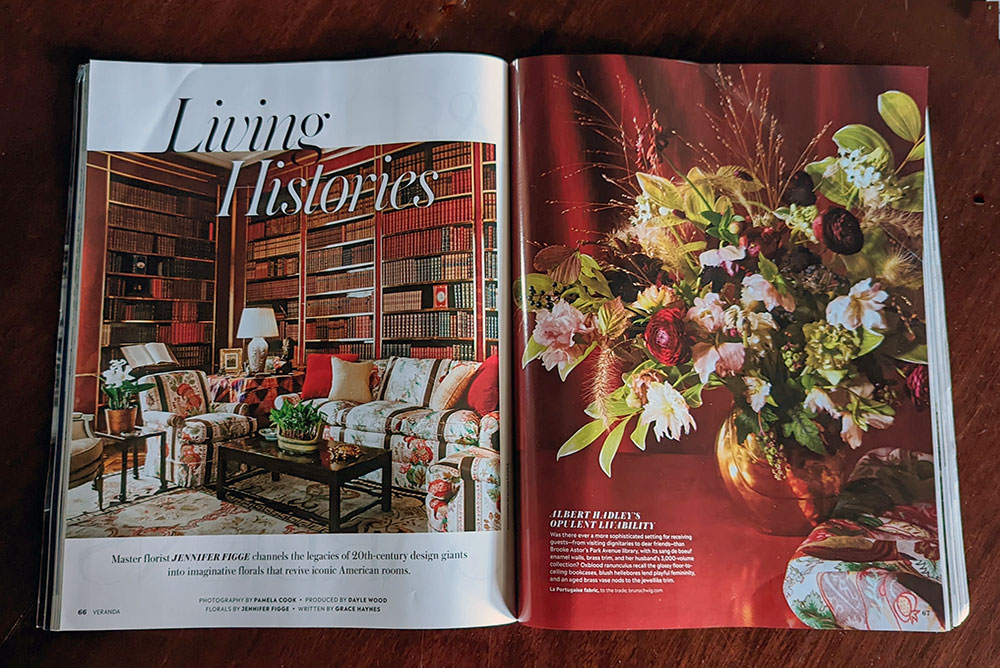
A spread from the current issue of Veranda magazine shows Brooke Astor’s storied Park Avenue library, designed by Albert Hadley (and photographed by William P. Steele). The spines of Astor’s husband’s leather-bound book collection supply the room’s base color, the reds picked up by florals by master florist Jennifer Figge. Her arrangement was photographed for the magazine by Pamela Cook. / Photo on front from iStock.
By Stephanie Cavanaugh
THE TREE is down, the fairy lights dimmed. Spring is months away. Has your home hit the doldrums?
In the most recent issue of the shelter magazine Veranda, the one with the turquoise dining room on the cover (a color I dream of painting our old Mustang convertible), there are eight home design features spread over 60 pages, offering an instant winter pick-me-up.
Within those pages are 58 rooms that include some form of greenery. There are bunches of flowers, some in tiny pots, others arranged in billows, branches of green leaves, ficus and orange trees, and ferns on pedestals. Some of the flowers are clearly expensive, massive bunches of roses begging for a sniff, orchids (of course), and elaborate florist-designed arrangements. Others are sweetly plucked from gardens or woods: Queen Anne’s lace, cosmos, ferns, sunflowers, evergreen branches.
They are displayed on tables, countertops, coffee tables, mantels, and bookcases; in living rooms, dining rooms, kitchens, and bathrooms. Sometimes they’re so enormous and elaborate that they smack you on the nose, sometimes they hide in plain sight, like a tiny posy on a nightstand.
Only four rooms have no plants or flowers: unsurprisingly, a bathroom and a mudroom; scandalously, a foyer (every entry needs a bit of welcoming greenery) and, oddly, a dining room, that despite its elegant furnishings is as inviting as a feast in a freezer in February.

Grey Gardens, the fabled Hamptons home of “Big Edie” and “Little Edie” Beale, cousins of Jacqueline Kennedy Onassis, over the years went from shabby to shabby chic to in-your-face glam, as redone by fashion entrepreneur Liz Lange. The current issue of Veranda features the dining room on the cover and the rest of the house on 10 pages inside, with photography by Pascal Chevallier. Here, as befits a cottage-style home, the flowers are Queen Anne’s lace and fronds seemingly plucked from the garden (although florals were in fact done by The Bridgehampton Florist.)
Take it from the design pros.
Flip through any shelter magazine and once you notice the extra dimension that plants and flowers add to a room, any room, it’s hard not to notice their absence. The steeliest, sleekest, most contemporary space is complemented, warmed, given an extra layer of dimension, by anything natural—even if it’s a naked branch, clipped from a tree. Or a bodacious boudoir, already fussed up with canopy bed, mirrored ceiling, and fireplace, is gifted an additional frisson of glamour by a vase stuffed with peonies, or a frilly palm.
No matter how beautiful a room, without a flower, a plant, even some leaves, the space can feel sterile and dead. Growing things add a layer of life.
A feature in the current issue of the magazine, “Living Histories,” pairs flower arrangements with the rooms of prominent (i.e., rich) people that were decorated or curated by famous designers, picking up the colors of the furnishings, playing with the mood.
One such is Brooke Astor’s carmine red library, with its flowery furnishings and black lacquer tables, designed by Albert Hadley. Collections of seemingly uncracked, leather-bound books, which seem to have been chosen for the color, line the brass-trimmed shelves that run floor to ceiling. In a companion photo, a flower arrangement by florist Jennifer Figge picks up the color with oxblood ranunculus, accented with pale pink hellebores, berry branches, and fizzy sprays of wild grasses—weedy things you might yank from the garden, here playing a prima donna role.
Something to keep in mind when you’re selecting flowers: Key them in color, scale, and shape to the room, your artwork, and your furnishings.
Take any painting, print, or photo of flowers, look at the colors, the mood. Say, you have a print of sunflowers. Try popping the real thing into a vase and setting it nearby—as if the flowers have waltzed out of the picture. Try a bunch of baby’s breath in front of a snowy scene. Tulips for a windmill or print of Holland. A potted palm beside a photo of last year’s trip to Bora Bora. The same holds for throw pillows and upholstery: Pick up the theme (if there is one) or the colors and let plants and flowers add punch to the setting.
For some great examples of flowers playing with art, mark your calendars for: the Philadelphia Flower Show (March 4-12, 2023), which always does a spectacular job with flowery vignettes. Also, the date is set for Washington DC’s Art in Bloom at Anderson House (March 27-30, 2023) but their website isn’t yet updated from last year. For a little road trip, the North Carolina Museum of Art in Raleigh offers Art in Bloom (March 15-19, 2023) with floral designers interpreting works of art in the museum’s collection.
